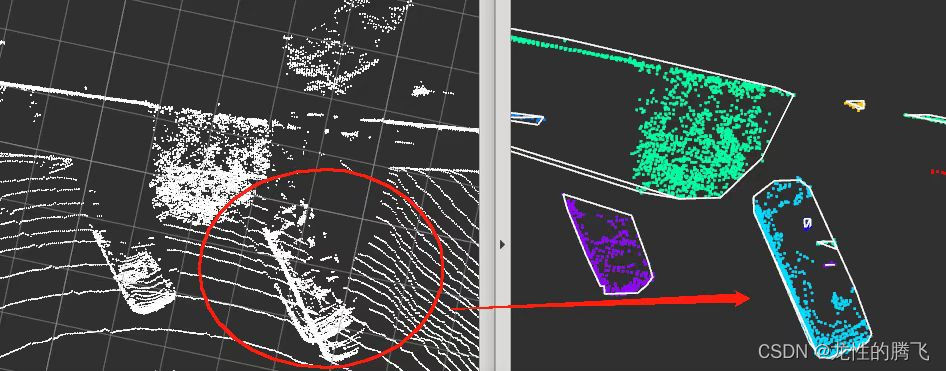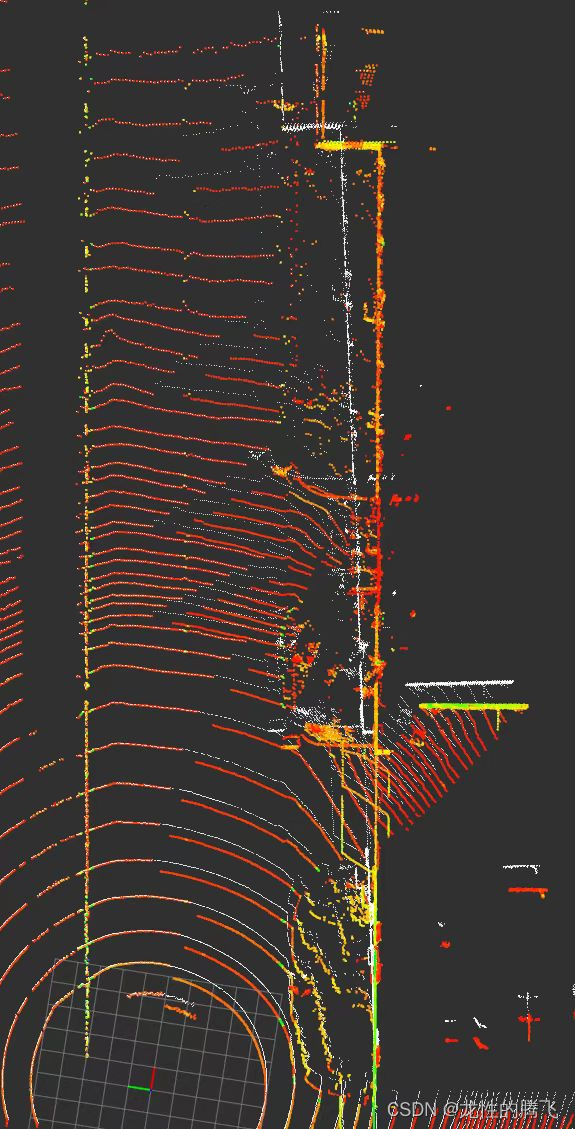0. 简介:激光雷达帧率一般为10hz, 也就是100ms一帧,在车辆高速行驶或者转弯时,一帧点云中的点并不是同一个坐标系下获得的测量结果,对于同一个目标在三维点云中就会出现畸变,这时要想获得精确的测量,就需要对点云做运动补偿,或者说即便校正,将同一帧点云中所有点统一到某一个时间点下的坐标系中。
1. 举例:如果做低速移动平台,可能对即便矫正的需求没有那么高,毕竟效果不明显,还额外增加了耗时,但是对于高速运动的车辆,激光雷达的运动畸变对于感知和定位都有着非常大的影响,是非常基础的一个环节。简单举几个例子:
(1)在起伏路面,激光雷达点云在一帧点云的起始位置会产生多条线的交错,在点云中形成高度差,仿佛检测到了目标,极易造成地面物检。
待补图
(2)如果一个目标正处于一帧点云的0-360度交叉处,试想一下车辆是72km/h, 就是20m/s,100ms时间就差了2m, 感知目标检测极有可能将目标检测为两个,造成误检,随着目标的移动两个目标可能合二为一,对于追踪预测,速度估计的精准度都会产生一定的影响。

如上图左侧展示的为旋转过程中点云的畸变,可以看到红圈中车辆出现重影,右侧为运动补偿后车辆点云的轮廓,清晰完整。
(3)对slam中建图定位更是需要运动补偿,没有运动补偿的点云在大规模建图极易跑偏,导致最后地图不在一个水平面上,点云的运动畸变相当于直接降低了激光测距的精度,从2-3cm精度下降到几十厘米甚至几米的误差,将直接导致定位精度无法提升,定位飘移问题。

如上图所示,白色为车辆在旋转过程中的原始点云,彩色为运动补偿后的点云,可以看到墙面发生了很严重的畸变,远处甚至到达了几米的差距,这种情况下没有运动补偿的情况下激光雷达定位效果肯定会变差。
2. apollo 程序
(1)程序在/apollo/modules/drivers/lidar/velodyne/compensator,apollo将运动补偿程序放到了lidar驱动的velodyne驱动下面,其他robosense和hesai的驱动也是用的这个模块,比apollo 3.0的代码结构更简洁了,3.0里面每个雷达驱动下面都有一个运动补偿程序,代码重复性很高。
(2)modules/drivers/lidar/velodyne/compensator/compensator_component.cc中Proc()函数就是主要函数,没什么东西,主要实现都在compensator.cc的
bool Compensator::MotionCompensation(
const std::shared_ptr<const PointCloud>& msg,
std::shared_ptr<PointCloud> msg_compensated) {
// 1. 获取原始点云的最大最小时间,前提是你的点云是带时间戳的
// 注意这里是用的uint64_t,计数是纳秒1s = 1e9ns
// GetTimestampInterval 这里直接暴力循环获得最大最小时间
// 2. 根据一帧点云的起始时间查询坐标变换tf激光雷达在世界坐标系下的两个位姿
// QueryPoseAffineFromTF2 就是ros里面tf查询该的
// 3. 根据时间戳对位姿进行插值,以最大的时间戳为基准,计算每个点和最后一个点时间差,计算坐标变换关系, 将点转换到最大时间点的坐标系下
// MotionCompensation
}(3)核心就是这个位姿插值坐标变换,这里做了一个判断,旋转误差是否显著--"significant",激光雷达在70m测据精度2cm, 一个显著的旋转应该是
0.02 / 70 = 0.0003 rad.
不显著的仅作坐标平移即可。
(计算部分解释参考第二篇博客apollo7.0------浅谈激光雷达运动补偿(二)--计算解析_龙性的腾飞的博客-CSDN博客)
void Compensator::MotionCompensation(
const std::shared_ptr<const PointCloud>& msg,
std::shared_ptr<PointCloud> msg_compensated, const uint64_t timestamp_min,
const uint64_t timestamp_max, const Eigen::Affine3d& pose_min_time,
const Eigen::Affine3d& pose_max_time) {
using std::abs;
using std::acos;
using std::sin;
Eigen::Vector3d translation =
pose_min_time.translation() - pose_max_time.translation();
Eigen::Quaterniond q_max(pose_max_time.linear());
Eigen::Quaterniond q_min(pose_min_time.linear());
Eigen::Quaterniond q1(q_max.conjugate() * q_min);
Eigen::Quaterniond q0(Eigen::Quaterniond::Identity());
q1.normalize();
translation = q_max.conjugate() * translation;
// int total = msg->width * msg->height;
double d = q0.dot(q1);
double abs_d = abs(d);
double f = 1.0 / static_cast<double>(timestamp_max - timestamp_min);
// Threshold for a "significant" rotation from min_time to max_time:
// The LiDAR range accuracy is ~2 cm. Over 70 meters range, it means an angle
// of 0.02 / 70 =
// 0.0003 rad. So, we consider a rotation "significant" only if the scalar
// part of quaternion is
// less than cos(0.0003 / 2) = 1 - 1e-8.
if (abs_d < 1.0 - 1.0e-8) {
double theta = acos(abs_d);
double sin_theta = sin(theta);
double c1_sign = (d > 0) ? 1 : -1;
for (const auto& point : msg->point()) {
float x_scalar = point.x();
if (std::isnan(x_scalar)) {
// if (config_.organized()) {
auto* point_new = msg_compensated->add_point();
point_new->CopyFrom(point);
// } else {
// AERROR << "nan point do not need motion compensation";
// }
continue;
}
float y_scalar = point.y();
float z_scalar = point.z();
Eigen::Vector3d p(x_scalar, y_scalar, z_scalar);
uint64_t tp = point.timestamp();
double t = static_cast<double>(timestamp_max - tp) * f;
Eigen::Translation3d ti(t * translation);
double c0 = sin((1 - t) * theta) / sin_theta;
double c1 = sin(t * theta) / sin_theta * c1_sign;
Eigen::Quaterniond qi(c0 * q0.coeffs() + c1 * q1.coeffs());
Eigen::Affine3d trans = ti * qi;
p = trans * p;
auto* point_new = msg_compensated->add_point();
point_new->set_intensity(point.intensity());
point_new->set_timestamp(point.timestamp());
point_new->set_x(static_cast<float>(p.x()));
point_new->set_y(static_cast<float>(p.y()));
point_new->set_z(static_cast<float>(p.z()));
}
return;
}
// Not a "significant" rotation. Do translation only.
for (auto& point : msg->point()) {
float x_scalar = point.x();
if (std::isnan(x_scalar)) {
AERROR << "nan point do not need motion compensation";
continue;
}
float y_scalar = point.y();
float z_scalar = point.z();
Eigen::Vector3d p(x_scalar, y_scalar, z_scalar);
uint64_t tp = point.timestamp();
double t = static_cast<double>(timestamp_max - tp) * f;
Eigen::Translation3d ti(t * translation);
p = ti * p;
auto* point_new = msg_compensated->add_point();
point_new->set_intensity(point.intensity());
point_new->set_timestamp(point.timestamp());
point_new->set_x(static_cast<float>(p.x()));
point_new->set_y(static_cast<float>(p.y()));
point_new->set_z(static_cast<float>(p.z()));
}
}在直行路上运动补偿效果如下:白色为原始点云,车辆向前行驶,激光雷达顺时针旋转









 本文详细介绍了激光雷达在高速运动时由于帧率限制导致的点云畸变问题,以及运动补偿在解决这一问题中的关键作用。通过实例展示了运动补偿前后的点云对比,强调了其对感知、定位和SLAM建图的重要性。Apollo开源项目中的运动补偿模块被提及,重点解析了位姿插值坐标变换的算法,以确保在不同速度下的精确测量。
本文详细介绍了激光雷达在高速运动时由于帧率限制导致的点云畸变问题,以及运动补偿在解决这一问题中的关键作用。通过实例展示了运动补偿前后的点云对比,强调了其对感知、定位和SLAM建图的重要性。Apollo开源项目中的运动补偿模块被提及,重点解析了位姿插值坐标变换的算法,以确保在不同速度下的精确测量。
















 937
937

 被折叠的 条评论
为什么被折叠?
被折叠的 条评论
为什么被折叠?








